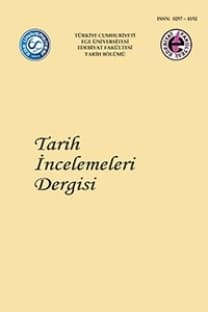1787-1792 Osmanlı Rus Savaşında Değişen Dengeler ve Yaş Antlaşması
Osmanlı
diplomasisine Moskof olarak geçen
Rusya ile olan ilişkiler, Kırım Hanı’nın aracılığıyla II. Mehmed zamanında
ticarete dayalı dostane temelli başlamış ve zamanla daha ziyade Kırım
üzerindeki hâkimiyet mücadelesinden dolayı çatışmalı bir hale dönüşmüştü. II.
Katerina dönemi Osmanlı-Rus siyasi ilişkilerinde önemli bir dönemi oluşturmaktaydı.
Zira bu dönemdeki Rus dış politikası, Osmanlı Devleti’ni ortadan kaldırıp yerine
İstanbul merkezli bir Rum Devleti kurmaya odaklanmıştı. Bu çalışmada 1787-1792
Osmanlı-Rus ve Avusturya savaşının nedenleri, savaş sonucunda Rusya’yla
imzalanan Yaş Antlaşması ve bu antlaşmanın imzalanma sürecinde Avrupa
devletlerinin katkısı ele alınmıştır. Çalışmanın ana kaynaklarını Başbakanlık
Osmanlı Arşivi’nde bulunan belgeler ile Londra Parlamento Arşivi’nde bu
antlaşmaya dair tutulan kayıtlar oluşturmaktadır. Her iki arşivde bulunan
kayıtlar kullanılarak Osmanlı-Rus tarihsel ilişkilerinin bir kesiti değerlendirilmeye
çalışılmıştır.
Anahtar Kelimeler:
Osmanlı Devleti, Rusya, Yaş Antlaşması, Prusya, İngiltere
Changing Balances During The 1787-1792 Ottoman-Russian And The Treaty Of Jassy
Relations with Russia which is known in Ottoman
diplomacy as Moskofstarted as a
commerce relation on friendly terms by way of Crimean Khan during the reign of
Mehmed the 2nd which over time transformed into a conflicting
relation due to the struggle for dominance over Crimea. The age of Katerina the
2nd was a significant period for the Ottoman-Russian political
relations. Because the Russian foreign policy during this time was focused on
eliminating the Ottoman Empire and founding an Istanbul based Byzantine Empire.
In this study, the causes for the 1787-1792 war between Ottoman-Russia and
Austria, Treaty of Jassy that took place after the war and the contributions of
European states during this treaty period have been taken into consideration. In the course of
the agreement, especially Britain and Prussia's efforts to protect the
territorial integrity of the Ottoman State as diplomatic attitudes and mediator
states have been elaborated on the basis of correspondence. As a result of the
efforts of the mediatory states, the Treaty of Jassy was signed between the
Ottoman State and Russia on January 10, 1792, and thus the ongoing war with
Russia was concluded. The main resources of the study are comprised of
documents in the Presidential Ottoman Archives along with the records on this
treaty found in the London Parliament Archive. The records in both archives
were used for evaluating a cross-section of the historical relationship between
Ottoman-Russia.
Keywords:
Ottoman Empire, Russia, Treaty of Jassy, Prussia, England,
___
- Ali Emiri Tasnifi, Sultan Selim III, (AE. SSLM. III) Ali Emiri Tasnifi, Sultan Abdühhamid I, (AE. SABH. I) Cevdet Askeriye (C. AS) Cevdet Dâhiliye (C. DH) Cevdet Hariciye (C. HR) Cevdet Bahriye (C. BH) Cevdet Saray (C. SM) Hatt-ı Hümayun (HAT) Divan-ı Hümayun Düvel-i Ecnebiye Kalemi (A.DVN. DVE.) Mühimme Defteri (A. DVNS. MHM. d.) Nâme-i Hümâyün Defteri (A. DVNS. NMH. d.) Mühimme-i Asâkir (A. DVNSASK. MHM. d.) İbnülemin Hariciye (İE. HR) Hariciye Nezareti Siyasi (HR.SYS) National Archives, London Parliamentary Archives ( NA, LPA.)
- ISSN: 0257-4152
- Başlangıç: 1983
- Yayıncı: Prof. Dr. Süleyman Özkan
Sayıdaki Diğer Makaleler
Eski Yakındoğu’da Yılanlı Tanrıça Kültü Üzerine Bir Değerlendirme
Kraliçe Tamara (Tamar) Devri (1184-1213) Gürcü Dış Politikası ve Bölgedeki Yansımaları
1787-1792 Osmanlı Rus Savaşında Değişen Dengeler ve Yaş Antlaşması
Effects of the Decisions of San Remo Conference on Syria and Iraq
Pergamon’un Yolları: Antikçağ’dan Bizans’a Bakırçay (Kaikos) Havzası’nın Yol Sistemi
Some Remarks About the Summer Period in Hittite Anatolia
